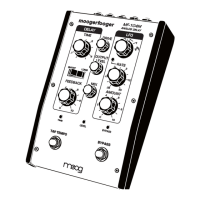DELAY TIME = .2
DELAY TIME = .6
FIGURE 9
Take a little time to experiment with various settings of the DELAY TIME,
SHORT/LONG switch, and FEEDBACK.
Here are some things you will notice:
•Changing the SHORT/LONG switch position either halves or doubles the
DELAY TIME and thus compresses or stretches the delayed signal currently
in the Delay Line by a factor of two. This results in the pitch of the delayed
signal being shifted up or down an octave.
•The FEEDBACK control creates the series of echoes by mixing a portion of
the delayed signal back into the Delay Line. With the control set to about
8, the echoes sustain indefinitely. With the FEEDBACK control set above 8,
the echoes build up chaotically into some amazing electronic textures that
can be both edgy and blurry at the same time.
GETTING TO KNOW THE LFO
This section demonstrates how the LFO
modulates the Delay Line.
Adjust all Delay controls as shown in Figure
10. Press the BYPASS control to bypass the
effect (BYPASS LED = Red).
Play your instrument for a few seconds. Tap
the BYPASS switch again to turn the effect
back on and play some more. Hear the dif-
ference? This is due to the fact that with the
effect on the Delay Line is still in the circuit
and is creating a very short (40 millisecond)
echo of the signal.
FIGURE 10
SHORT LONG
.2
.1
.6
.3
0
0
.05
0
Adjust the FEEDBACK as shown in Figure 7, and tap the
BYPASS switch to turn the effect OFF. Then press and hold
the BYPASS switch until the LED turns orange. The MF-104M
is now in SPILLOVER mode.
Play your instrument to build up some echoes in the Delay
Line. Now tap the BYPASS switch to turn the effect off while
continuing to play. The signal from your instrument will not
be sent through the effect but any audio currently in the
circuit will continue to sound as if the effect were on. Pressing
and holding the BYPASS button for two seconds toggles
your Analog Delay between modes.
•In NORMAL mode, turning the effect OFF shuts off audio
from the Delay Line. Any new signals bypass the effect.
•In SPILLOVER mode, turning the effect OFF allows audio
currently in the Delay Line to continue while any new signals
bypass the effect.
Play your instrument while turning the TIME control as in
Figure 8. You’ll hear the pitch of the delayed signal change
briefly and then return to pitch.
As you change the DELAY TIME the signal becomes
stretched or compressed as it goes through the delay circuit,
thereby speeding up or slowing down the vibrations.
When you change the DELAY TIME you are changing the
clock rate of an oscillator that determines how fast signals
go through the individual circuits in the Bucket Brigade
Device (see Figure 9).
Adjust your LFO controls as shown in Figure 11. Play your
instrument and you’ll hear a classic chorus effect. How
does this happen?
We just noted that changing the DELAY TIME changes how
fast signals go through BBD in the Delay Line. And, you’ll
remember that changing the TIME will cause pitch shifting
of audio already in the Delay Line due to time compression
and expansion of the signal.
In the MF-104M the LFO is used to modify (or modulate) the
rate at which signals go through the BBD based on the chosen
WAVEFORM, RATE, and AMOUNT. In this example of a
chorus effect, the LFO is smoothly modulating the TIME with
a slowly changing sine wave of low amplitude (small peaks
and troughs). Because the sine wave is “gentle”, only minor
pitch shifting occurs.
FIGURE 11
.8
4

